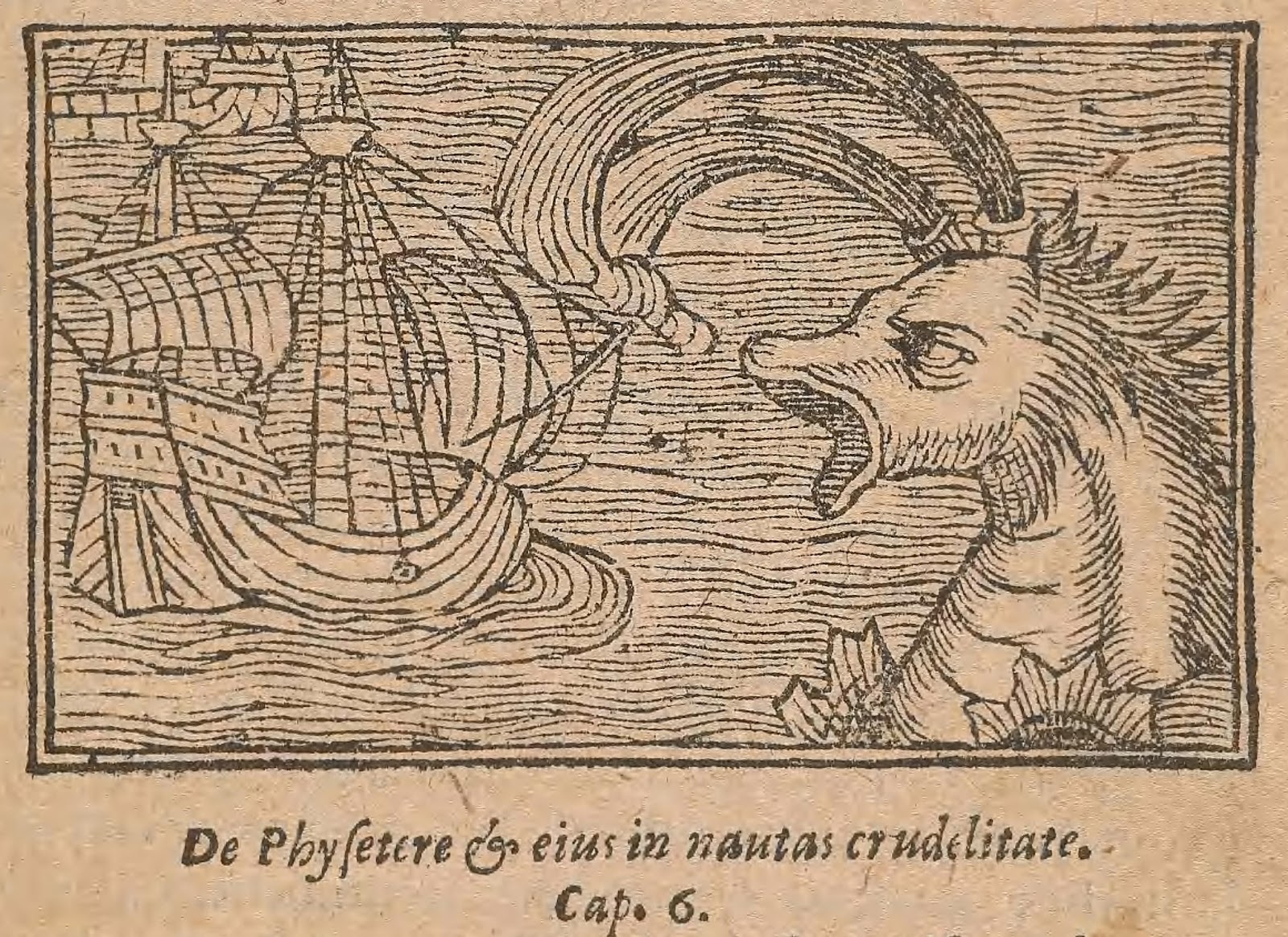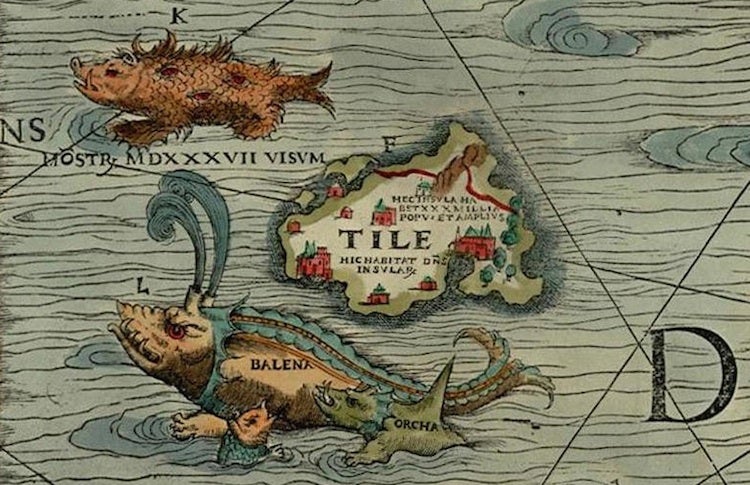Welcome to No Fear Friday, where I good-natured-ly make fun of bad
artwork from the Middle Ages, to hopefully inspire those interested in
the scribal arts to give it a try. This week:
Whales!
Whales are fun, and are also one of those creatures which were rarely seen in their entirety... so they are portrayed in Medieval art all sorts of wrong. And it is delightful.
that being said, in order to properly recognize a whale in a medieval manuscript, it is helpful to ask these four questions:
1. Is it so incredibly big it is either...
a) ...the size of a boat, or bigger?
b) ...able to eat an entire school of fish in one gulp?
2. Is Jonah emerging from its mouth?
3. Is it shooting water from out its head?
4. Is a fire being lit on its back?
If the answer to any of these four questions is 'yes,' then it is most likely a whale.
Wait...Fire?
Yes, fire. This excerpt is from a book published in 1555 called A Description of the Northern Peoples:
"The whale's skin has a surface that looks like sand on the seashore. Hence, when it raises it's back above the waves, as it frequently does, sailors completely mistake it for an island. So, they put in, disembark, drive stakes in to tie their vessels too, and kindle fires to cook their food, till the whale, at last feeling the heat, plunges into the depths. Then those who remain on it's back are drowned."
It then goes on to reference similar stories from other, earlier books, where entire ships are lost from anchoring on a whale and then getting pulled under when the whale feels the heat from the fires.... or just barely escape such a fate, often with loss of some sailors. This sort of story appears in a work written by Ambrose in the 700's AD, and in stories about Saint Brendan the Navigator in the 900's AD... So this was a well known trope about Whales in the medieval world.
 |
| Bibliothèque Nationale de France, fr. 1951, Folio 30r |
 |
| Bodleian Library, MS. Bodley 764, Folio 107r |
 |
| British Library, Royal MS 2 B. vii, Folio 111r | |
 |
| London, British Library, Harley MS 4751, f. 69r, c. 1230-1240 |
 |
| Northern Italy, ca. 1290, MS M.459 fol. 21v, The Morgan Library |
.....fire, Fire, FIRE! Moral of the story, if you come across a small island in the middle of the ocean, make sure that it's not alive before lighting a fire on its back. But do you also see how all of these whales basically just look like fish? How would you know it's a whale without the cooking fire?
FOUS- Fish of Unusual Size
 |
| Bodleian Library, MS. Douce 151, Folio 80v |
Big as a boat.
 |
| Harley 3244
f. 60v
|
Bigger than a Boat
![Isidore of Seville [7th century CE] Whales are immense beasts, with bodies equal to mountains. They have their name from emitting water, for the Greek ballein means emit; they raise waves higher than those of any other sea beast. They are called monsters (cete) because of their horribleness. The whale that swallowed Jonah was of such size that its belly resembled hell; as Jonah says (Jonah 2:2): “He heard me from the belly of hell.” image: Bodleian Library, MS. Ashmole 1511, Folio 8](https://i.pinimg.com/564x/8d/e6/e5/8de6e57ff0d14d0f2cd9dc49935d47c8.jpg) |
| Bodleian Library, MS. Ashmole 1511, Folio 86v |
Big as a boat and eating two fish at once!
 |
| Bodleian Library, MS. Laud Misc. 247, Folio 157r |
Big as a boat and eating THREE fish at once.
 |
| Merton College Library, MS. 249, Folio 8r |
BIGGER than a boat and eating an ENTIRE SCHOOL of fish at once!
 |
| British Library, Arundel 66, detail of f. 43v |
So big it is full of STARS!
Ok but this last one is really an illustration of the constellation of Cetus, AKA 'the whale,' from
Astrological compilation and political prophecies written in 1490. So the stars are less a commentary on its size than... ok look,
I thought it was funny!
Blow Holes and other Features
 |
| 1562 Map of America by Diego Gutiérrez |
These are all just delightful, starting with this guy and his doofy looking face. They are all also mostly later period. I'm guessing that somewhere in the early 1500's it became more common knowledge that blowholes are a thing because they start showing up in a lot of woodcuts and illustrations.
 |
| Harley 3244 f. 65 |
This is the only earlier period illustration I've found that seems to reference whale blow holes, c. 1236. And even then we are not entirely sure if the whale blows it out a hole, or his mouth.
 |
| Konrad Von Gesner - Details From “Historia Animalium” (History Of Animals) 1551-87 |
There's the cook fire again. And Feet!
 |
| Magnus, Olaus. Historiae de gentibus septentrionalibus. 1555 |
 |
| Nova typis transacta navigatio novi orbis Indiæ occidentalis,
by Bernardo Buil in 1621 |
 |
Carta Marina, a map by Olaus Magnus, 1527-1539
|

Yup, those are whales. They even have 'balena' and 'orcha' helpfully written on their backs.
So what we've seen so far.. blowholes, specifically two per whale, feet... oh! Tusks! It's like people took the concept of 'the biggest creature in the sea' and decided they had to have tusks like the biggest creature on land. And I'm talking about elephants of course. Maybe that's also where the feet are coming from. And it's a feature in some earlier illustrations too:
 |
St. Petersberg Public Library, LPL.Lat.Q.V.III, N 1, F. 47, 12th century
LPL.Lat.Q.V.III, N 1, f. 47 v.
Read more at:
http://cultureru.com/category/architecture/saint-petersburg-architecture/the-saint-petersburg-public-library/the-medieval-bestiary/page/4/
|
Big as a boat, check. Fire, check, but look at those magnificent tusks!
Ok, Jonah...
I'm just going to share these because there are a lot of them and they're all awesome. We've got big fish, serpent tails, the list goes on and on. But at the end of the day, is the sea monster swallowing Jonah? Whale!
 |
| Jona wird vom Walfisch ausgespien. Heidelberg - Universitätsbibliothek. Cod. Pal. germ. 432, fol. 040v |
 |
| 15th century initial from the Ranworth Antiphonal. |
 |
| Gallica BnF, Sacramentarium gelasianum, C 700-800AD |
 |
| British Library, Royal 17 E VII
f. 105
|
 |
| British Library Add. MS 54215 c 1265-1270 |
 |
The Stuttgart Psalter, c 830 CE |
 |
| The Stuttgart Psalter, c 830 CE |
 |
| Bibliothèque Nationale de France, lat. 6838B, Folio 36v |
 |
| British Library Royal 15 D III |
 |
| Griechen berhuempesten Gschichtschreibers sech Bucher, 1554, by Diodori des Siciliers |
 |
Pamplona Bible, Navarre 1197.
Amiens, Bibliothèque municipale, ms. 108, fol. 146r |
A Whale of a Tale
![via @socialhistoryox Jonah, escaping from the whale [source?]](https://i.pinimg.com/564x/05/13/61/051361af5973d8d7bb273cda15b75bd9.jpg) |
| 1645 woodcut |
Ok this one needs commentary because that is not actually Jonah there, but it IS a whale. It also has a story behind it.
It's from a phamplet printed in 1645 called (I'm not kidding)
'The Sea Wonder: a true and wonderful relation of a Whale pursued in
the Sea, and incountered by multitudes of other Fishes as it was
certified by divers Mariners of Weymouth, who, comming from France in
the good ship called the Bonaventure,
did shoote the said Whale, which making to Land did 65
strike
upon the Shore, within three miles of Weymouth, where being opened
there was found in the belly of it a Romish Priest, with Pardon for
divers Papists in England and Ireland, whose names are here inserted.’
So... religious turmoil in England, someone made up a story about how they found a whale who has swallowed a priest who was carrying pardons for any papists in England who needed it, and by the way here are their specific names!
Next post in the series: TBD
Previous post in the series: Manicules!
Sources:









![Isidore of Seville [7th century CE] Whales are immense beasts, with bodies equal to mountains. They have their name from emitting water, for the Greek ballein means emit; they raise waves higher than those of any other sea beast. They are called monsters (cete) because of their horribleness. The whale that swallowed Jonah was of such size that its belly resembled hell; as Jonah says (Jonah 2:2): “He heard me from the belly of hell.” image: Bodleian Library, MS. Ashmole 1511, Folio 8](https://i.pinimg.com/564x/8d/e6/e5/8de6e57ff0d14d0f2cd9dc49935d47c8.jpg)






















![via @socialhistoryox Jonah, escaping from the whale [source?]](https://i.pinimg.com/564x/05/13/61/051361af5973d8d7bb273cda15b75bd9.jpg)
Comments
Post a Comment